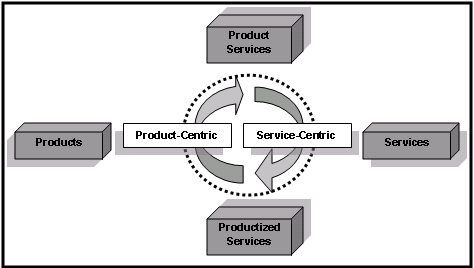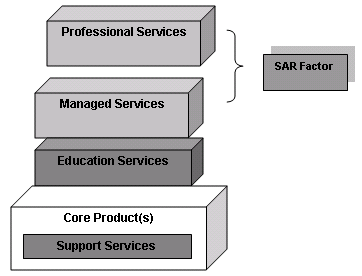Building Professional Services – Preface
The Sirens’ Song
First edition; 288 pages
ISBN 0-13-035389-2
( by:Mitch Peterson, Steve O’Conner, Harris Kern, Thomas Lah )
Preface
Professional Services at a Product Company
May 31st, 2001. Bill Gates grants a live interview. He appears on CNBC’s “Squawk Box” to promote Microsoft’s latest software release. Two minutes into the interview, host Mark Haines wants to know about Microsoft’s service strategy: Isn’t Mr. Gates concerned that Microsoft doesn’t enjoy the same level of service revenues that Oracle and IBM do? Mr. Gates responds that Microsoft is now offering new consulting services. A visit to the Microsoft Web page confirms the new direction. (see Fig.0-1).
A quick search on www.google.com using the key words “Professional Services” and “Product” yields hundreds of Web sites for technology product companies also offering professional services. Besides Oracle and IBM, the who’s who list includes hardware manufacturers Alcatel, Aspect, Compaq, EMC, HP, Lucent, Nortel, and Sun; software makers PeopleSoft, Sybase, WebCT, Pumatech, and Red Hat. All of these technology companies have heard it. They can’t ignore it. The Siren’s Song of Services.
Microsoft Consulting Services Portfolio of Services
Microsoft® Consulting Services(MCS) provide help directly from Microsoft through every stage of the technology planning, deployment, and support process. MCS is staffed with Microsoft experts who can help you make the most of your IT investment. Specializing in real-life IT solutions, MCS offers a full range of programs for advanced technology requirements: e-commerce, enterprise applications planning, distributed network architecture computing, and more. Customers around the world have used MCS to improve productivity and establish a competitive advantage. With more than 100 offices and just under 4,000 consultants worldwide, Microsoft has the experience and expertise to align your IT vision and business goals. The following are some of the services we offer.
The Gartner Group has documented an identity crisis that both product and service companies constantly go through: Product companies want to become service companies and service companies want to become product companies. This Product-Services wheel is shown in Figure 0-2. For product companies offering technology, the turning point begins with product services, or services offered to support the core products of the company. These are commonly known as support services. But soon, the product company may be tempted to move in a different direction.
1 There is a Tide in the Affairs of Vendors: Product or Service Business?” Gartner Group, May 2000.
2 In Chapter 12, we review the service strategies of HP, Compaq, Sun, and EMC. From this review, it should become clear why companies like Compaq are motivated to move to offer consulting services.
3 In fact, the definition of professional services is very nebulous in the industry. Figure 0-2 provides a helpful and simple way to visualize and classify the various types of service offerings in which product companies invest.

Figure 0-2 Product-Services Wheel
In particular, the Sirens’ call of potentially high growth and high-margin consulting services for a product company is almost too tempting to resist, especially if the product company is experiencing erosion in product margins. 2. If you visit the Web sites of product companies such as IBM, HP, Compaq, EMC, and Silicon Graphics, you see very consistent positioning of their newly developed services. All of these product companies now offer at least four distinct flavors of services: 3
Support Services: These are basic break-fix support services that product companies have always offered.
Education Services: These are traditional product-training services offered by product companies.
Managed Services: These are services focused on successfully implementing the core products of the company. Typically, these services are tightly scoped and very similar from customer to customer. They are usually offered at a fixed price.
Consulting (or Professional) Services: These are services that move beyond implementation and into integrating the products of the company into the customer’s business. These services may involve developing custom code to integrate the product into existing infrastructure. These services may also involve consulting with the customer on actual workflow and business processes.
For the larger product companies like IBM and HP, a fifth service is offered:
Outsourcing: These are services where the product company literally takes over the day-to-day operations of the customer’s technical environment.
Table 0-1 provides a summary of the five types of services that product companies are now likely to offer. And there is good reason for product companies to develop and offer all these new services: over half of all Information Technology (IT) spending is on services! 4 Key customers often turn to their preferred and trusted product vendors to provide more and more of these services. According to the Gartner Group, this behavior is being driven by three factors: the continuing shortage of qualified technical talent, the trend of companies to refocus on their core competencies, and the ever-increasing complexity of new technology requiring specialized expertise for successful implementation.5
4. “IT Service Spending in the Crosswinds,” p.4, The Gartner Group, September 25, 2000
5. Ibid

Figure 0-3 Product Services
These product companies see this opportunity for new service revenues. Figure 0-3 illustrates the traditional service opportunities on which a product company would focus: support services and education services- both are closely related to the core product of the company. But now, product companies are exploring new service opportunities that seem very attractive (light gray). There are managed services, which are more complex than standard support services but are still closely related to the products of the company. And, they are typically being delivered by support-service personnel who have downtime between support calls. This means managed services don’t represent an investment in incremental staff to deliver the services. Finally, there are professional services, which may or may not be directly related to the product, but they do represent an incremental investment in new skill types.
The nice thing about professional-services revenues is that they don’t seem to have all the messy strings attached to them that product revenues do: no product qualification process, no backwards-compatibility discussions, and no never-ending support worries. With these high-level consulting services, it appears the product-service company can be “in and out.” They collect their money and move on. Or do they? No, not really. In fact, consulting services are just as complex and risky to deliver as any new product. Every service-centric company can validate this fact. Unfortunately, no product-centric company believes it can be true. And, here begins the rub! Not only are professional services complex to deliver, there are business risks to providing professional services that many product companies do not understand at first. If the new professional services offered by the product company are not aligned and somehow anchored to their product, there is the risk that the services will be both unprofitable and counterproductive to the objectives of the product company. We refer to this risk as the services alignment risk (SAR) factor. In chapter 2, we discuss this risk factor in more detail.
One of the oldest stories known to western Civilization is the Odyssey composed by the Greek poet Homer. In the story of the Odyssey, there is a conflict between a man named Odysseus and the Greek god Poseidon. Poseidon does not want Odysseus to return home to Ithaca, so the god hurls one challenge after another toward the tormented man. But this is not the true conflict. The defining conflict Odysseus faces is between intelligence and his arrogance. On the hand, he is a very smart man. His wits brought about the fall of Troy (it was his idea to build the Trojan horse), and his wits allow him to survive each challenge the gods present. But his intelligence and success make him arrogant-arrogant enough to believe he needs no assistance from any man or any god. This arrogance fuels the wrath of Poseidon. Not until Odysseus acknowledges his limitations is he permitted to return home.
Product companies face the identical challenge that Odysseus faced. They are skilled and successful at bringing products to market. They have money from lucrative product margins to invest in new endeavors. They are confident in their business savvy. But this confidence becomes a harmful blinder as they enter the world of providing services.
When service points are thin or customer engagements go awry, the product company has difficulty acknowledging it has entered a new realm- a realm where the natural laws are different, requiring new frameworks to succeed. This reality leads us to our first “Sirens’ Song.” Throughout this book, we will be highlighting false perceptions held by many product companies regarding professional services. Because these perceptions can prove deadly, we have named them Sirens’ Songs after the beautiful yet deadly monsters from the Odyssey. These Sirens were creatures that sang enchantingly to passing sailors, only to lead the sailors to crash into unseen boulders. The misperceptions we will be highlighting have the same effect: If they are not recognized, they can lead a product company to crash its service business.
Now, for our first Sirens’ Song of Services:
Sirens’ Song: Professional services are not dramatically different from support services or education services.
Boulder Ahead: The truth is professional services are dramatically different from other services typically offered by product companies. They are different in size, scope, and risk. They operate under a different financial model. Finally, they are the first service a product company offers that does not have to be directly linked to the product portfolio of the company.
Have we scared you? Good. But don’t get too scared. Despite the potential hazards, there are many compelling reasons for a product-centric company to move forward from basic support services.
Good Reasons to Offer New Services
Beyond pursuing additional revenue opportunities, there are many sound business reasons product companies offer more than just product support services. The Services Marketing Advisors Association provides this standard list of reasons: 6
- Client interest in business solutions as opposed to point products
- Deeper client relationships and improved account control
- Increased revenue per customer:
- 50 to 100 percent higher revenues from both products and services
- Product pull-through 8
- Increased margins
- Greater implementation control
- Improved customer satisfaction
In Living on the Fault Line, Geoffrey Moore provides an updated list of why technology companies specifically need an internal professional-services organization:
- To help implement projects that advance the company’s state of the art, featuring products that are fresh from R & D.
- To do the gritty, unglamorous work behind the scenes that has to be done to make the system work right. This is the very work that independent consulting firms want no part of.
- To develop domain expertise in one or more vertical markets to help differentiate the company’s existing products.
Moore states that by providing professional services, a product company can take on problems for long-established customers that no one else will tackle. “Not only does this help secure long-term loyalty and commitment, but it can also lead to the discovery of new market opportunities.” 9
And in reality, there are benefits to the end customer. By providing consulting services directly, the product-centric company can succeed in the following ways:
- Provide one-stop shopping for implementation
- Provide hard-to-find product expertise and technical skills
- Decrease time to complete the customer solution
- Allow customers to focus on their core competencies
- Provide a single point of contact
- Provide a single point of liability
These last two points are especially attractive to understaffed, overworked IT managers who have enough vendor relationships to juggle as it is. When coauthor Steve O’Connor was CIO at silicon Graphics, he drove his IT organization to work with a short list of seven strategic vendors. “I didn’t feel my management (team) and I could build effective relationships with more than seven vendors.” The practice reclaims cycles for the IT management team and creates deeper, more productive relationships with vendors.
6. “Training Fish to Fly? Seven Tips to Convert a Product Sales Force to Solutions Selling,” June 2001, www.itsma.com/education/prof_dev/pd_052901.html.
7. “Should Professional Services Be in Your Company’s Services Portfolio?” Shera Mikelson, Hahn Consulting.
8. Product pull-through is the act of leading with service sales and then pulling product sales in.
9. Geoffrey Moore, Living on the Fault Line, New York: Harper Collins, 2000
So, with a win-win situation in mind, the product company cranks the product-service wheel and begins offering new services to the customer.
The customer buys them. And then, the real fun begins: the fun of actually delivering these services in a consistent and profitable manner. For most product companies, this is when the journey begins to get rough. Engineering and implementing products profitably is one set of skills, doing the same for services is quite another. The principles are often the same, but their application is very different. If services are not managed properly, the product company may soon find its hard-won product margins being used to subsidize unprofitable service engagements.
Sirens’ Song: Professional services should be a high-margin component of a product company’s portfolio.
Boulder Ahead: The truth is many product companies are experiencing lower than expected margins from their professional-services business. Gross margins for professional -services business units have been running at 15 percent to 20 percent with net operating profits of zero.
In reality, some of the best and brightest product companies have struggled to maintain a profit in the journey of building a services organization. 10 IBM is used constantly as the poster child for success-a model for how a product company can transition itself into a true service and solution provider. But how many companies have the deep pockets of IBM? How many companies have a locked-in legacy install base that can carry them through the painful and unprofitable transition IBM went through? Not many. And, how many other examples of success have you read about? How long is the list of product companies that have actually developed a successful and profitable service organization that offers more than basic support services? The number of articles describing product companies that want to offer more complex services is endless. The number of articles documenting favorable results is almost nonexistent.
We know the service waters look inviting. We know you want to set sail. But are you prepared to navigate these waters? Have you built the right ship? Do you have the right maps? If the answer is no, not even Poseidon himself will be able to save you from the shipwreck ahead. This book is designed to help the product company listen to the Sirens’ Song of services without the sailing into the rocks, to help the product company succeed as it turns the product -service wheel without succumbing to blind arrogance.
10. “Should Professional Services Be in Your Company’s Services Portfolio?” Shera Mikelson, Hahn Consulting

















